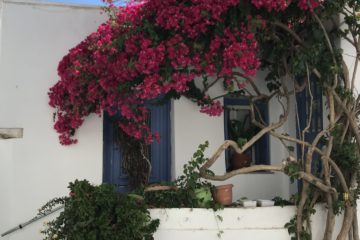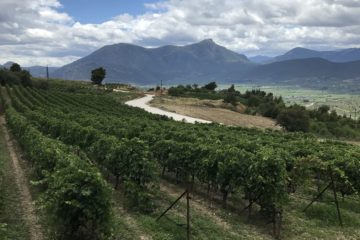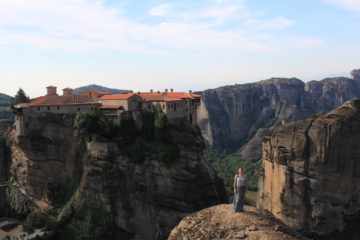After our two days in Zhangjiajie National Forest, I wasn’t sure what scenery could possibly come close to comparing with the view’s we’d had. But Rorie discovered a huge valley known as the Zhangjiajie Grand Canyon with a famous glass bridge [Editor’s note: The largest and longest glass bottom bridge in the world. NBD.] that you can walk across while looking down at the canyon floor far below.
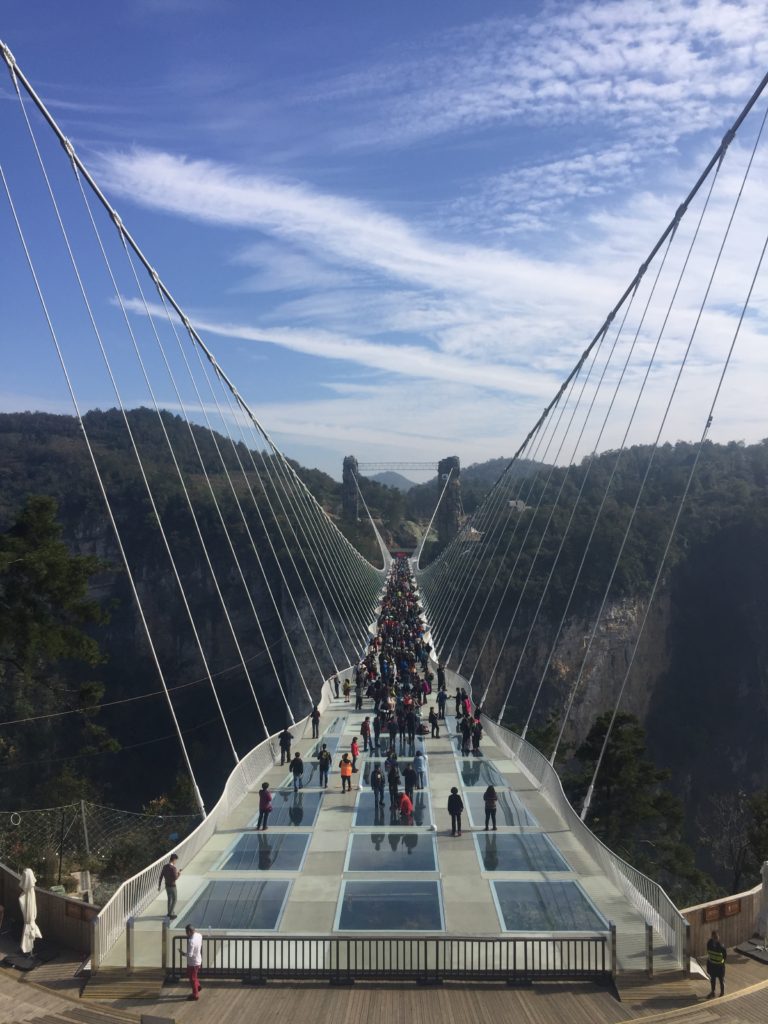
The glass bridge at the Zhangjiajie Grand Canyon
We took a city bus to the Grand Canyon and made our way to the glass bridge. It’s not completely glass, though it does have huge glass panels that give you a view of the canyon floor below. You have to wear fabric booties over your shoes to avoid scratching up the glass too much, so once we were appropriately outfitted we set out onto the bridge. Apparently the custom is to lie down on it and take pictures at various angles, so the entire bridge was covered in Chinese tourists in various prone and seated positions with selfie sticks. [Editor’s note: They looked ridiculous. Chinese tourist photo poses are a source of endless comedy and amusement.]
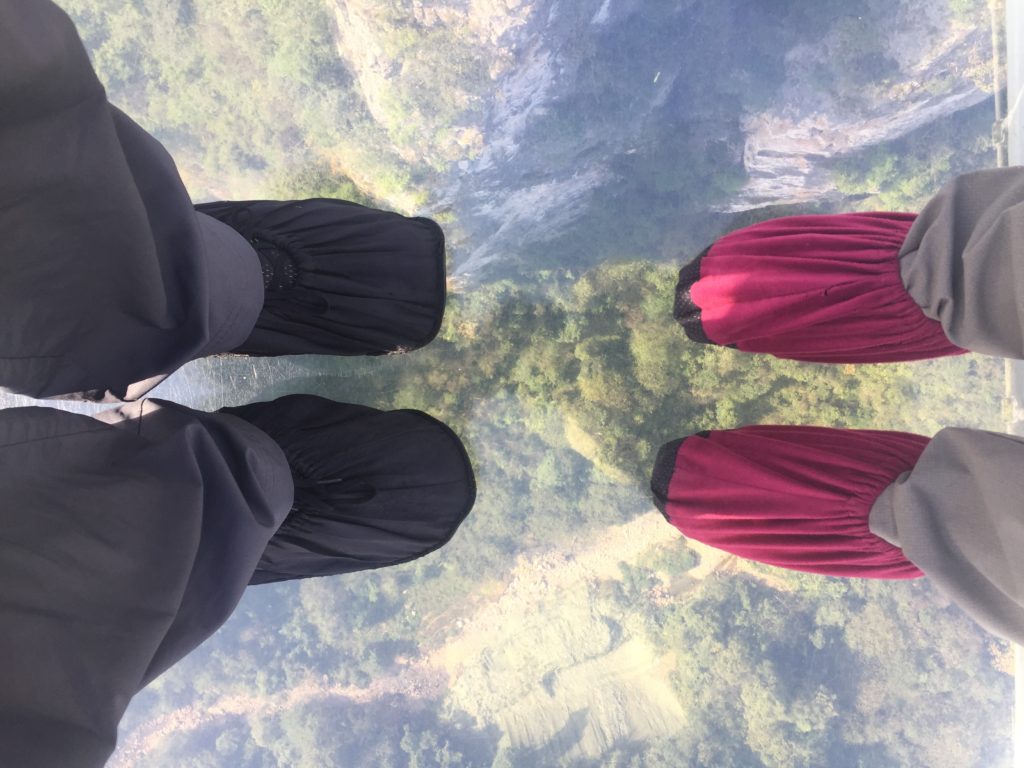
Looking down past our booties to the canyon below.
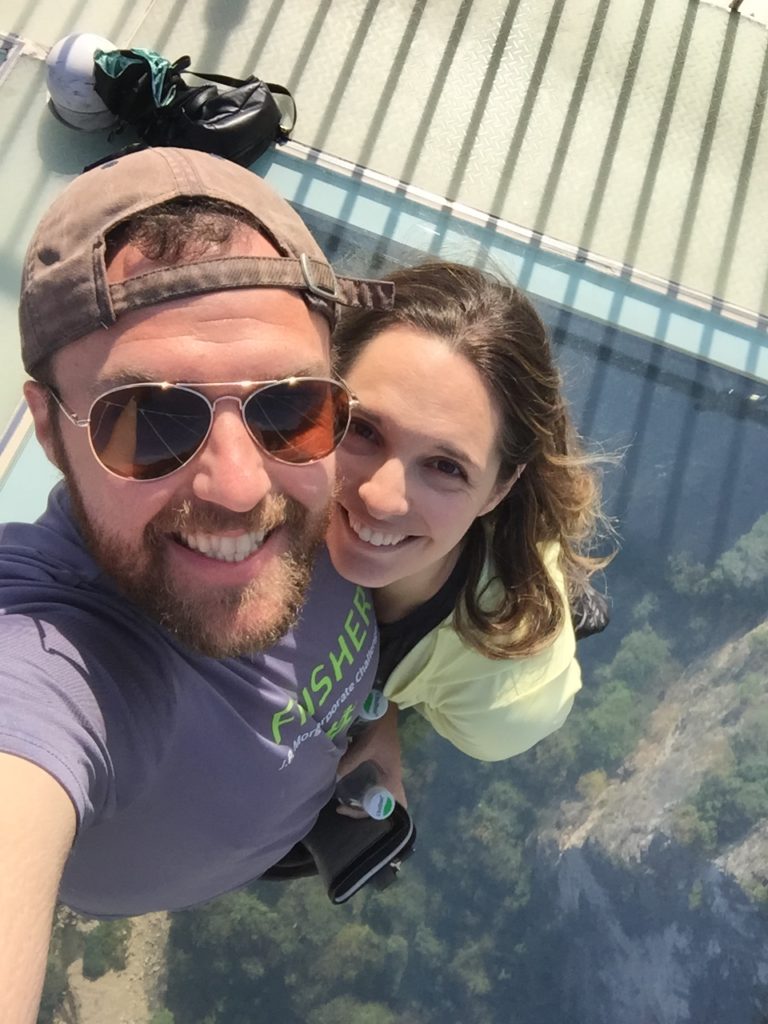
After dutifully taking our version of the lying down photos, we moved on to the far end of the bridge, where you continue a long hiking loop down many flights of stairs hugging the cliff (by this point, our calves were sore from the previous two days but we felt like stair experts) and along a beautiful riverside walking path through the bottom of the valley, culminating in a serene boat ride back to an area with food stalls and parking lots.
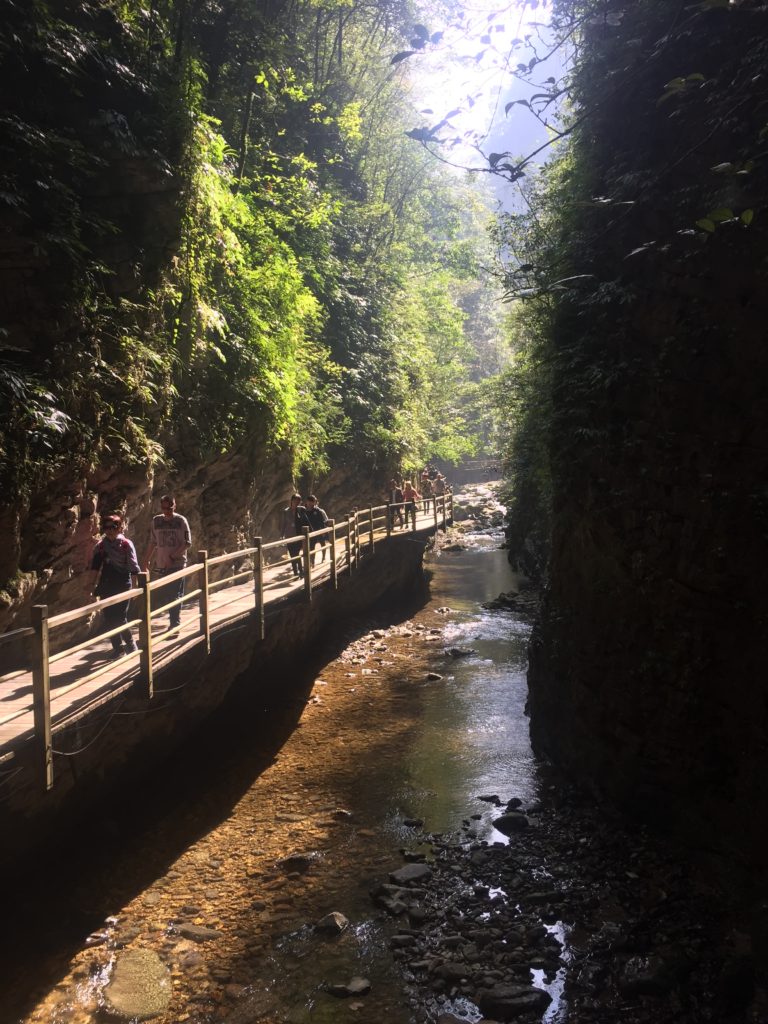
Part of the riverside pathway through the lovely canyon.
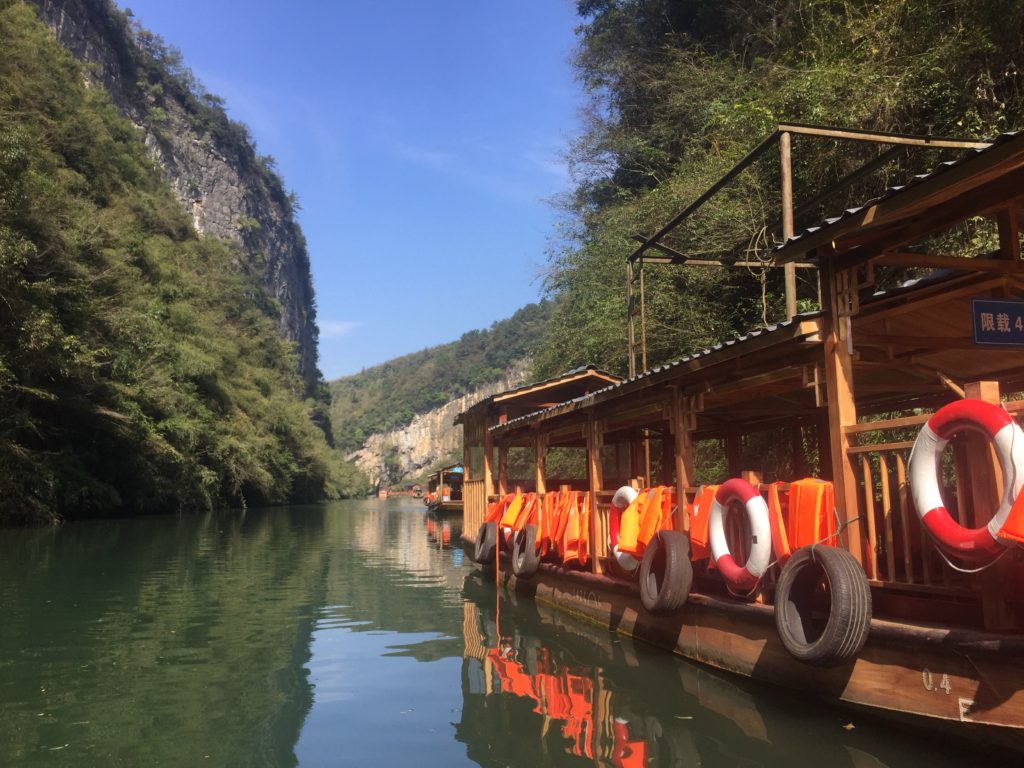
The peaceful boat ride to finish the journey
I have to say, while the hike along the river was very pretty, and the bridge was kind of cool to do, I wouldn’t recommend it to others. It was expensive and not quite as thrilling as it was made out to be. After the scenery of the previous days, it felt almost like a letdown from that perspective, though it certainly was not a wasted day by any means. Plus, the Tianmen Mountain hike that we did the following day had glass-bottom walkways that were (in my opinion) even more adrenaline-inducing than the bridge, so with hindsight just hiking Tianmen Mountain would have been plenty. [Editor’s note: I begrudgingly agree with Jess. While I thought the canyon bottom of the Grand Canyon was very worthwhile, it was redundant of (and inferior to) the other superior sights at the other locations. This is what it looks like to have way too many beautiful sights to visit in a single trip.] After getting back to Wulingyuan and collecting our bags, we hopped on a 45-minute bus back to Zhangjiajie City where Tianmen Mountain is located.
Before we could get there, though, we had to find our hostel. We’d gotten (perhaps overly) confident over the previous five-ish weeks, and had a system down whereby we’d screenshot several versions of maps and the address written in English and Chinese so that when we arrived in a new city we could either find it ourselves or communicate with a taxi driver to get there. This hostel, however, didn’t have the address in Chinese anywhere we could find on the internet, effectively taking the taxi option off the table, no phone number, and also didn’t show up on any map searches. Rorie marked the spot that looked closest to the map shown on the booking site we used and determined it should be no more than a 15 minute walk from the bus station. After walking to the spot on the map and wandering around the narrow alleyways for a while without seeing anything that looked remotely like the hostel, we realized this was not going to be easy. Eventually we found a different hotel and an extremely nice woman who spoke a couple words of English to help us. She eventually looked up the hostel on her own phone, found a phone number, called them for us, and arranged for them to send a taxi to pick us up. It turns out that the map on the booking site was completely wrong, and we were not even in the right part of town. Luckily though, the hostel paid for the cab and apologized for the issue, and their actual location ended up being even more convenient to the spot we were headed the following day. We chalked it up to the Nothing Is Ever Easy files and went to bed. [Editor’s note: To be abundantly clear, we realized I was not at fault at all for this snafu. The hotel screwed up and I did my best to locate an spot that didn’t exist. I’m absolved.]
Our final full day in China was dedicated to Tianmen Mountain, also known as Heaven’s Gate and famous for its 999 steps leading up to the Gate, the natural opening in the stone that is visible from all over the city. Here, like most places in China, the infrastructure is incredibly impressive and well organized. There is the world’s longest cable car leading to the top straight from the middle of the city, a full 30-minute ride that takes you over city streets, village farmland, and finally up onto the mountain. There is also a bus that takes you to the bottom of the steps, which itself is famous for driving along a road with 99 sharp hairpin curves, a road that has been the location of plenty of extreme sporting events over the years, as well as an extensive system of escalators carved through the inside of the mountain to get you from the top to the Heavens gate formation. These three modes of transportation form a large loop, so the typical path is to take the cable car up, then the escalator, stairs, and bus down, or vice versa.
Because we’d heard that the morning lines for the cable car could be ridiculous, plus the woman at the hostel who offered to book us discounted tickets told us that most of the morning timeslots were sold out, we opted for the reverse route that would have us start on the bus, followed by walking up the 999 steps and taking the escalator, then ending with the cable car ride back down. After seeing the lines in the morning for the cable car, I think we made the right decision. We got to jump right on our bus in the morning with no delay, then end our day with a leisurely and relaxing ride. Plus, after walking up all those steps, I felt like I had earned dessert.
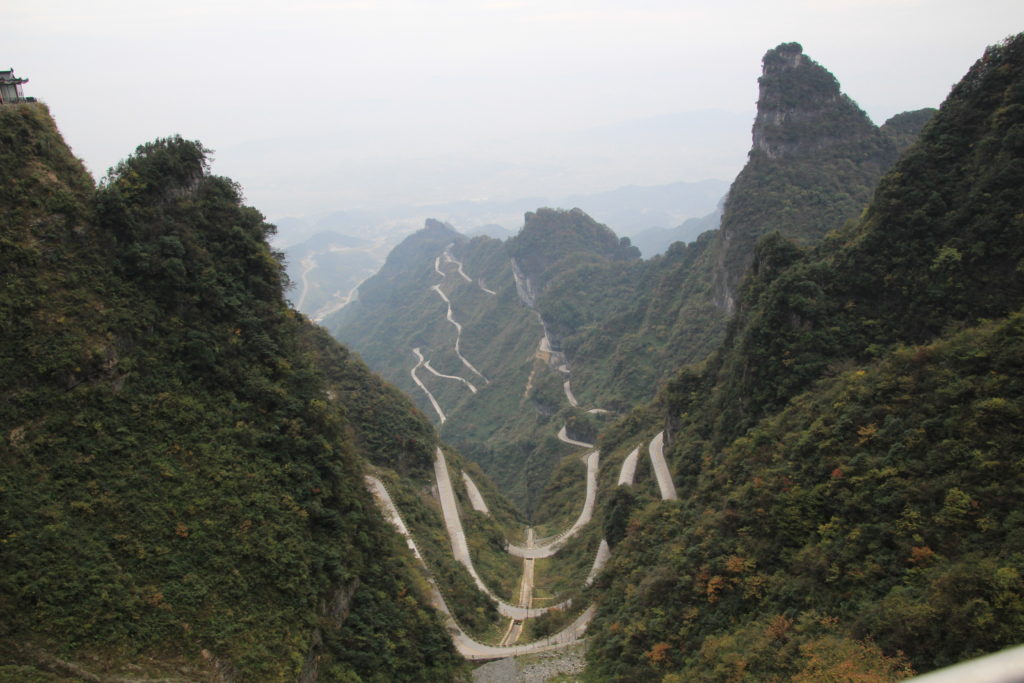
Part of the road our bus climbed shockingly quickly to get to the 999 steps.
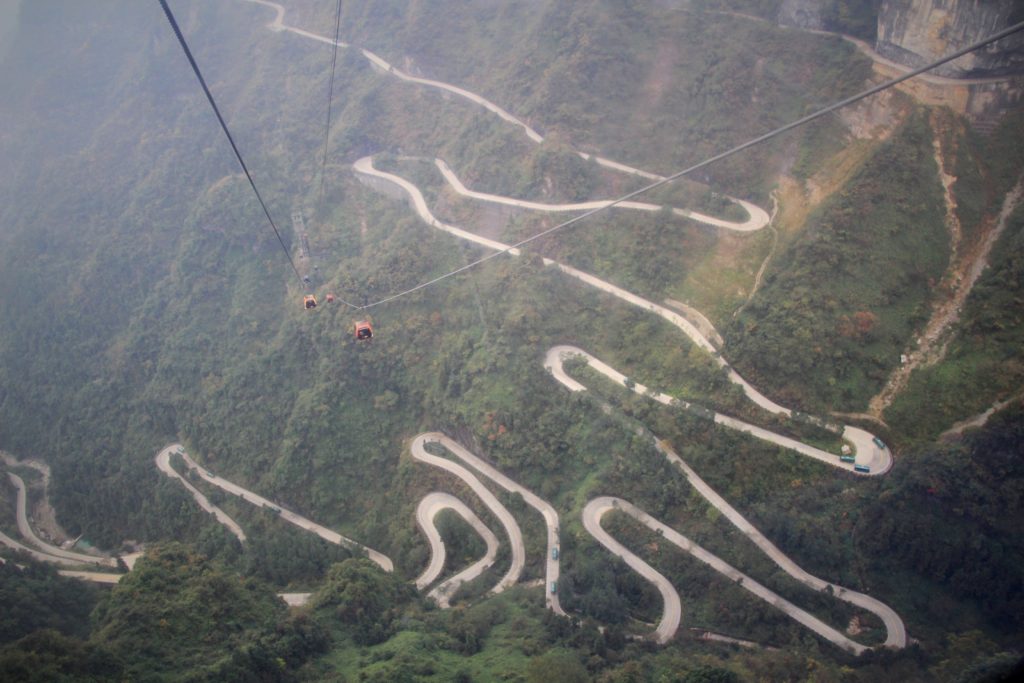
Aerial view of the road. Wheeeeeeeeholycrapwheeeeeee….
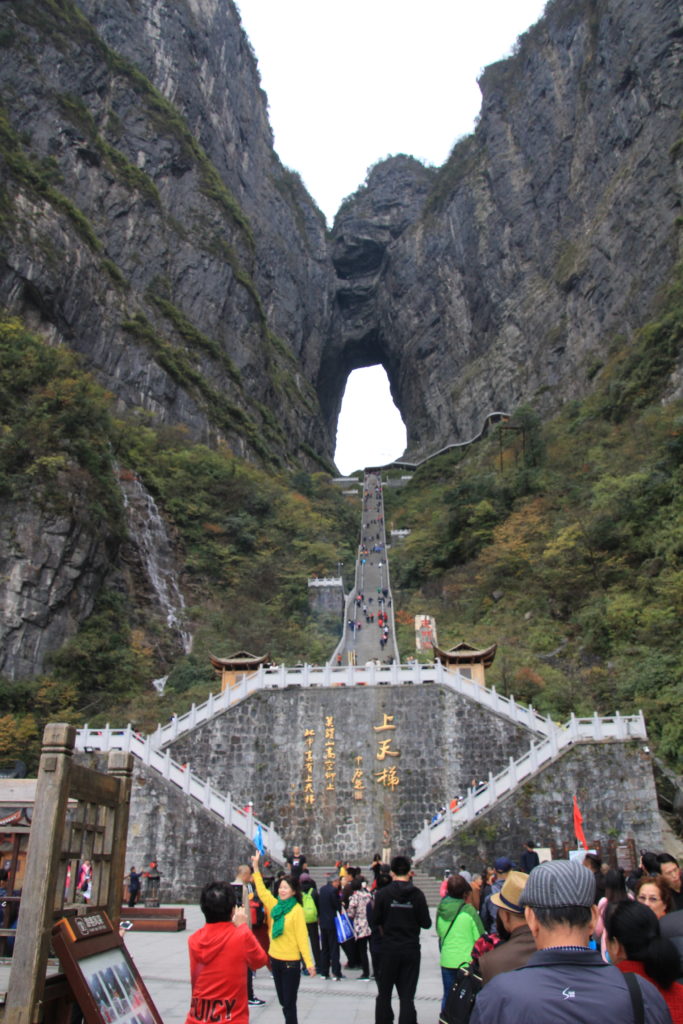
Looking up at the Stairway to Heaven and Heaven’s Gate from the base of the steps.
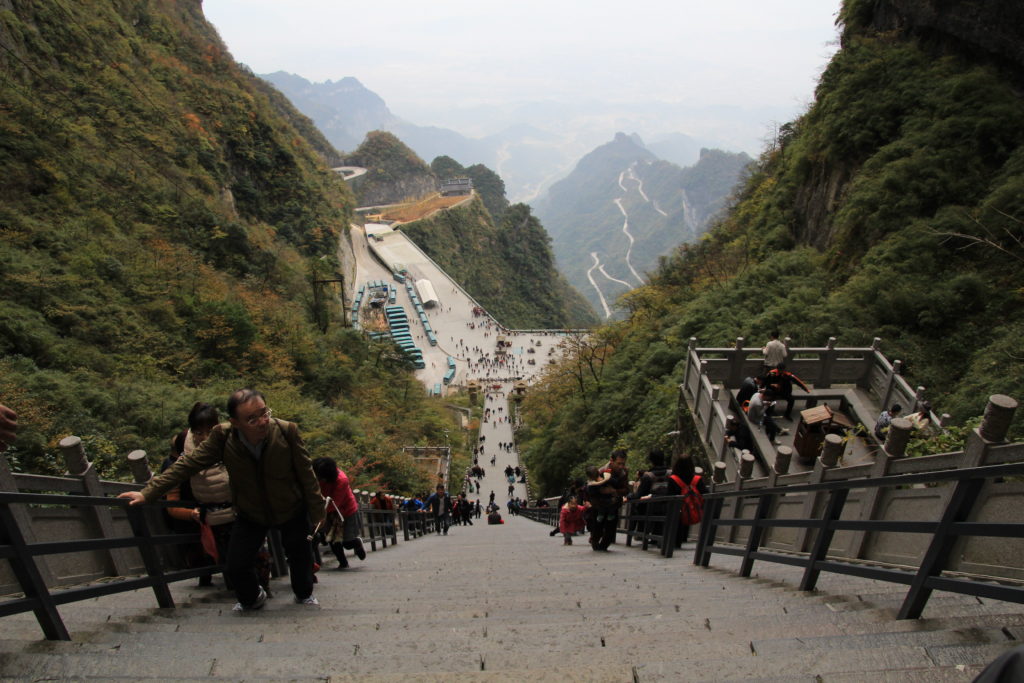
The view back down the steps from partway up.
After surviving the bus ride (they are NOT kidding about those hairpin turns. I was happy I’d taken motion sickness medicine beforehand) [Editor’s note: Jess was basically like a scared cat with her claws dug into my leg as we navigated each of the ridiculously sharp hairpin turns. It was both amusing and terrifying.], and surviving the stair climb (just in case my legs weren’t tired enough after the previous three days of hiking), we headed up the escalators to the top of the mountain. I hadn’t known what to expect but was pleasantly surprised by the amount of stuff to do. There was a long hiking loop with beautiful overlooks, cliffside pathways built on terrifyingly sheer cliff walls, and some glass-bottom walkways that to me, rivaled or exceeded the Zhangjiajie Grand Canyon for the stomach-dropping effect. Overall we had a full day, and I left feeling really glad we had done it and happy we were ending our time in China with beautiful natural scenery. [Editor’s note: For what it’s worth, I think the views and hiking on Tianmen Mountain were some of the most beautiful of our trip. I was absolutely expecting to be underwhelmed by them since the actual hiking is secondary to the cable ride and Heaven’s Gate, but it was extremely pretty and the glass planks were excellent.]
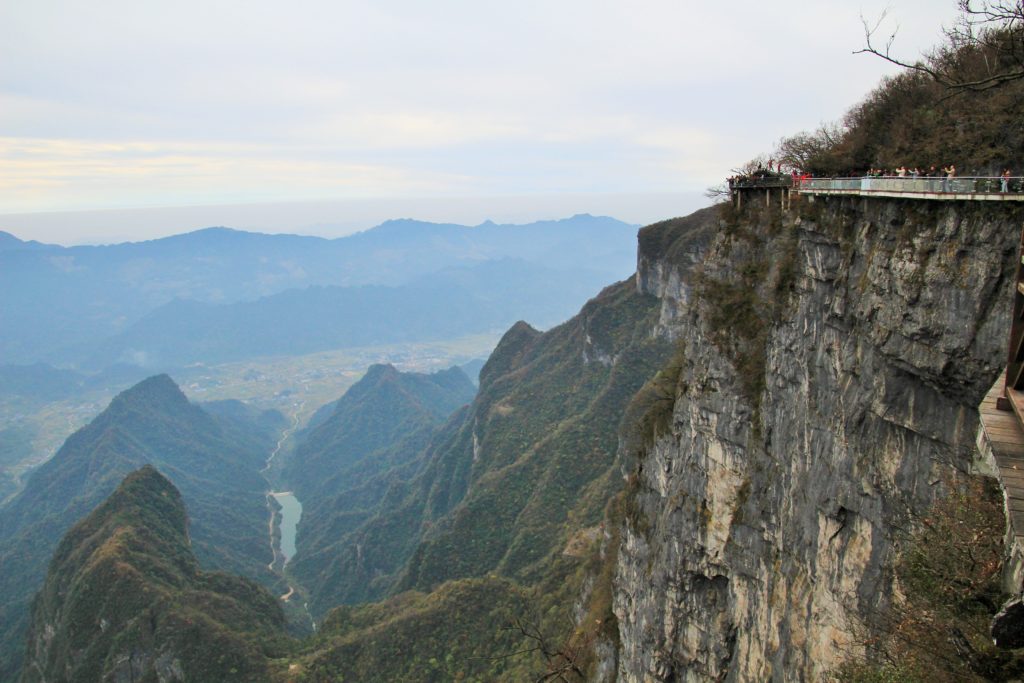
A cliffside path on top of the mountain (upper right of the photo).
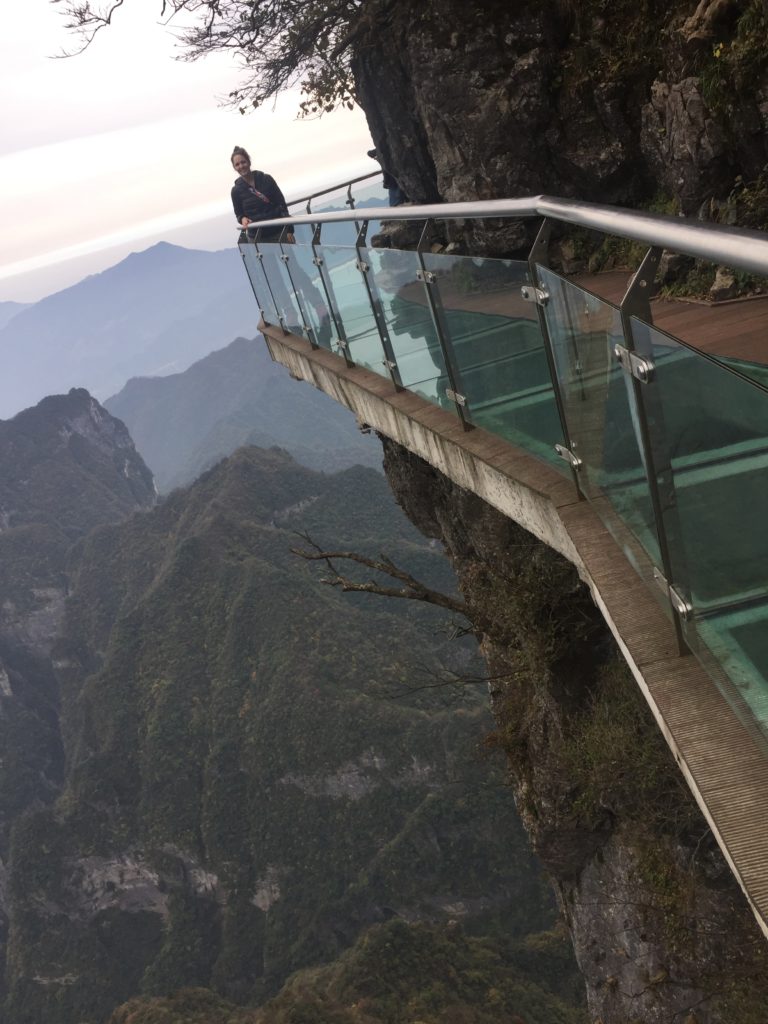
Hanging out on the side of a cliff on a glass walkway, trying not to look down
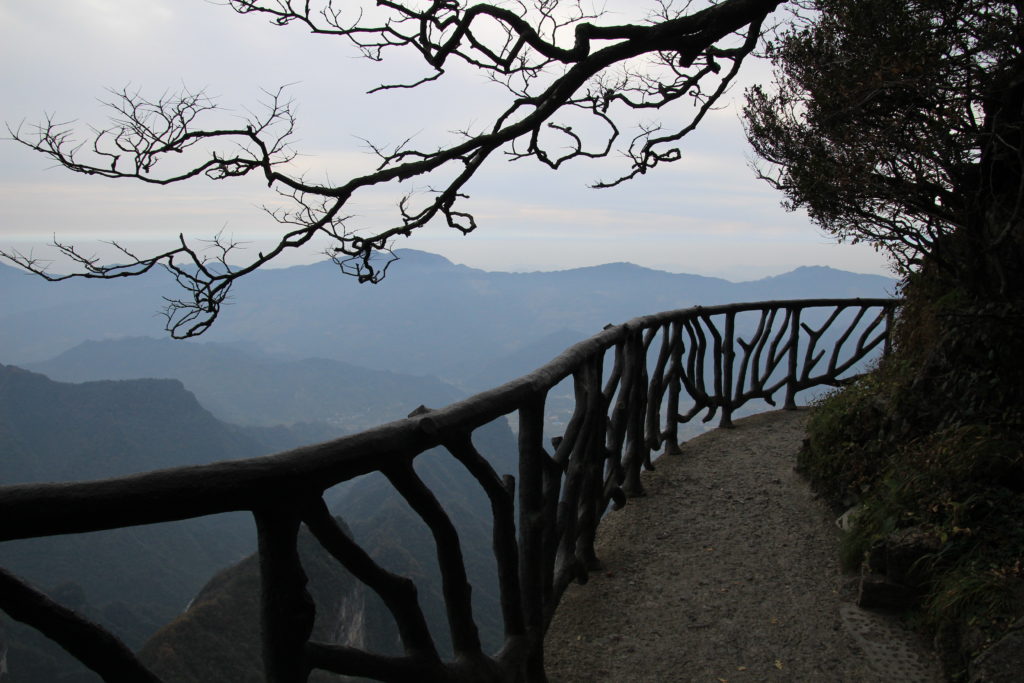
View from a cliffside path.
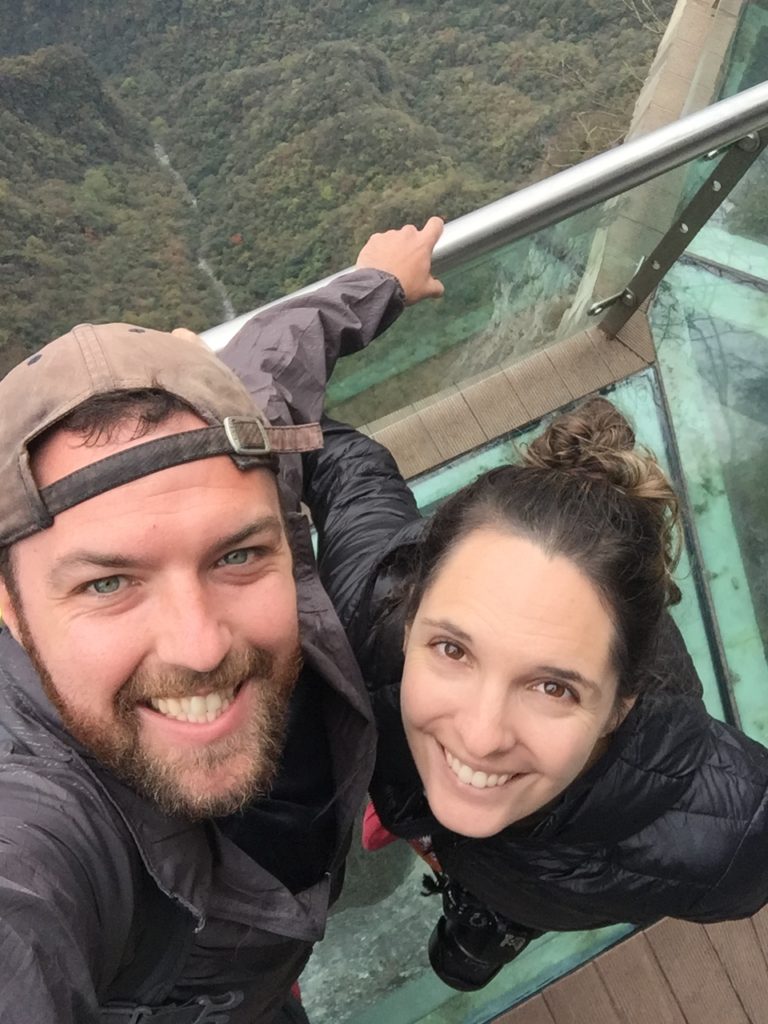
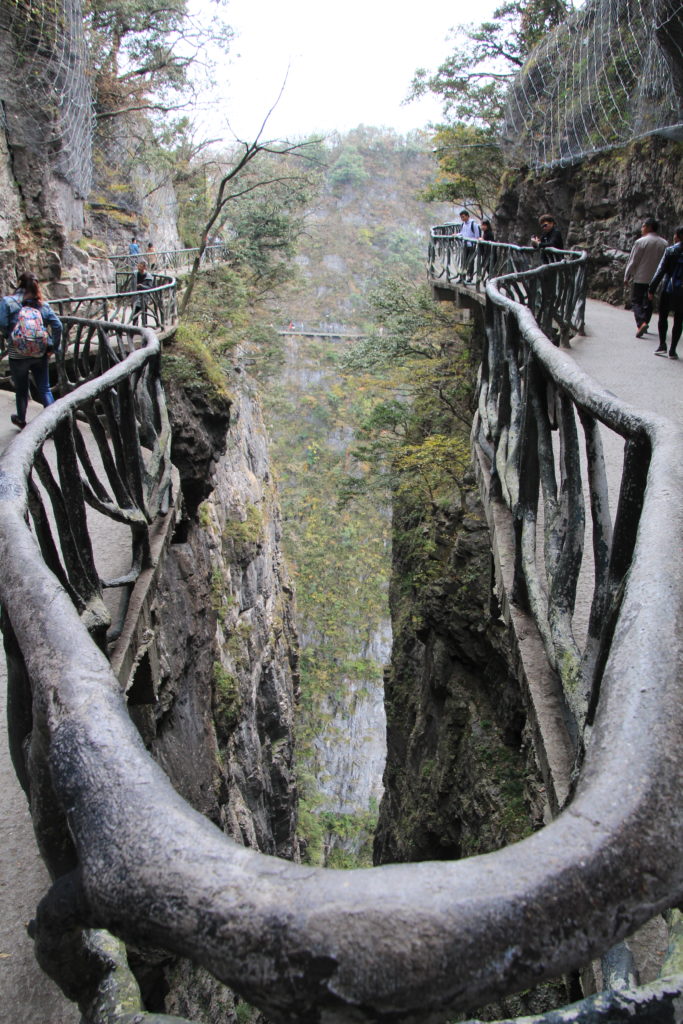
A hairpin turn in the cliffside railing.
